- Powell doesn’t provide firm timeline for tapering: stocks, Treasuries, commodities rise; dollar falls
- Surprisingly, investors still rotate back into the Reflation Trade
Can ongoing record breaking rallies for the S&P 500 and NASDAQ Composite as well as near record highs for the Dow Jones and Russell 2000 continue as Septermber begins? Historically, since 1945, that's the month that's consistently been the worst period of the year for equities.
Without doubt, it's also the question traders are likely asking as they wonder whether the momentum that pushed stocks to their highest levels in history will be enough to offset a variety of ongoing risks including the resurgence of the Delta variant of COVID-19 as it escalates worldwide.
Bulls took charge of the market on Friday after Federal Reserve Chair Jerome Powell, speaking at the central bank's annual Jackson Hole symposium, indicated the Fed was in no rush to hike rates, but would possibly begin tapering its asset purchases "this year." Still, though that sounds like good news for investors in the short-term, the market narrative is rife with geopolitical, economic, and health-related worries.
Though Powell's message was anticlimactic, with no specific timeline provided, and the delivery was dovish, the Fed chair did create the expectation of potential changes by providing a possible catalyst via this coming Friday’s, August Nonfarm Payrolls report after he mentioned there's room for improvement in the US job market. It's anyone's guess, at this point, if next Friday's data will be a sufficient prompt for the Fed to finally become more hawkish.
Reflation Trade Back In Play
All major US indexes climbed on the final day of last week's trade, however the prevailing pattern was the reflation trade. The Russell 2000—which lists small cap domestic firms that benefit from a reopening economy and are often referred to as value stocks—outperformed, surging 3%, while the NASDAQ 100, the index that includes the pandemic technology darlings known as growth shares, barely added 1%.
The daily details tell an even clearer story: when analyzing the 11 SPX sectors, the numbers show a distinct investor preference for value sectors. Energy jumped 2.7%, followed by Financials and Materials, each rising 1.3%. The Technology sector couldn’t even muster a full percentage point, though Communication Services did rise 1.6%.
The switch back to stocks sensitive to economic growth was even more pronounced in the weekly view, with energy catapulting 7.5%, followed by Financials’ 3.5% jump, Materials’ 2.6% gains and 2.25% advance for Industrials. Technology gained less than 1.5% for the week, with Communication Services again doing better, + 2.4%.
This rotation back from growth, once again into value, goes as far back as in the monthly view, with Financials gaining 7%, followed by a boost for Materials of 4.1%. Technology came in third with a 3.3% rally. Over this time frame, Communication Services lagged, up just 2.2%.
We admit we found it puzzling that investors would prefer to take a risk on cyclicals considering the Fed is prolonging its full-scale stimulus, which has been benefitting technology shares specifically. The fears surrounding Fed tightening were that Technology, the sector considered long overdue for a correction, would take the brunt of an announcement of a timeline to taper QE. Since no such announcement was forthcoming, we would have expected Tech stocks to receive a boost, not shares associated with the Reflation Trade.
This surprise is underscored by the fact that stocks sensitive to an economic recovery have already outperformed. The Russell 2000 is about 135% from the March 2020 bottom, while the NASDAQ 100 is only 128% up in the same period.
Having said that, the NASDAQ 100’s chart demonstrates a much more decisive bullish presence than the Russell 2000, which has been meandering since its March 2021 record.
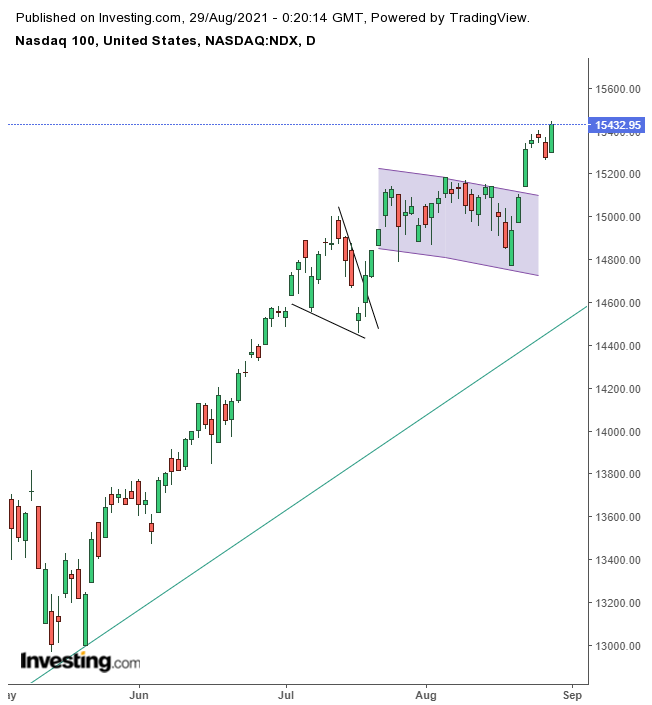
The mega cap tech index has formed back-to-back continuation patterns within a clear uptrend.
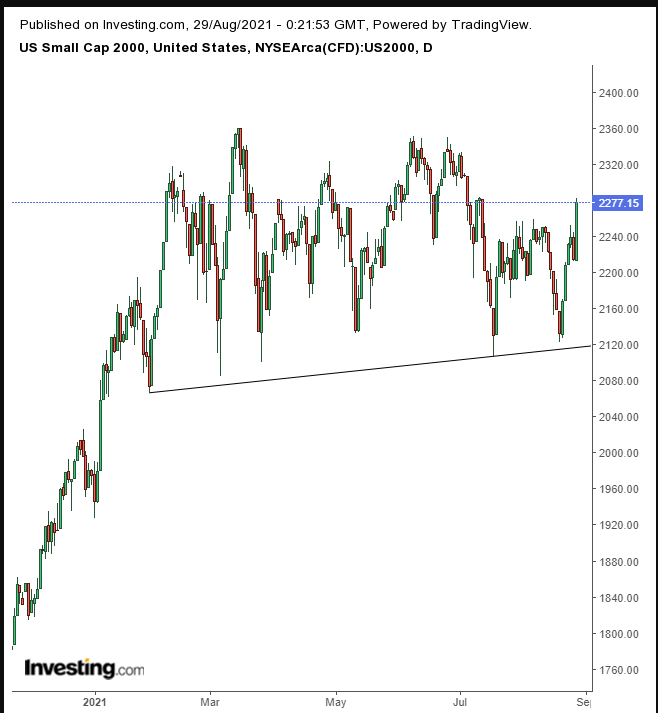
The Russell has been trendless since notching its March record high, which raises the risk of the index topping out.
On Friday, yields, including for the 10-year benchmark Treasury, fell back.
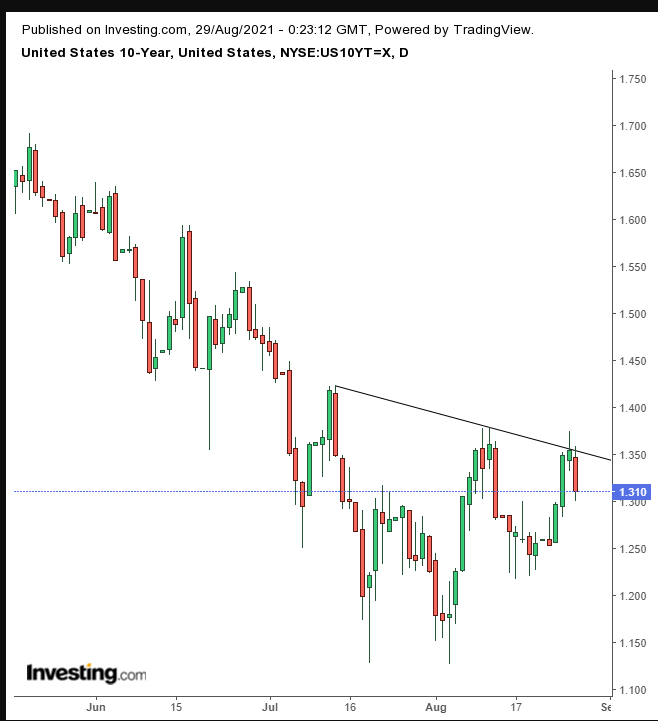
The drop came after rates penetrated the neckline of a potential H&S bottom, on an intraday basis.
Dollar traders priced in a longer wait for the Fed to cut back on available cash, strengthening the greenback.
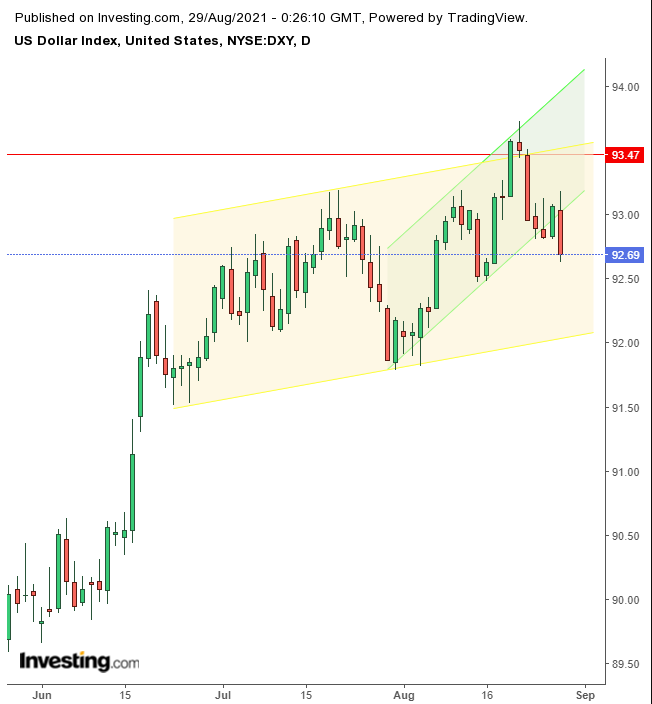
The USD distanced itself from the neckline of a massive double-bottom, falling below a rising channel since the July 30 low (green channel), while returning toward the bottom of its more tempered (yellow) rising channel since the June 23 low, having reached its top.
Gold, was buoyed by dollar weakness, threatening a reversal.
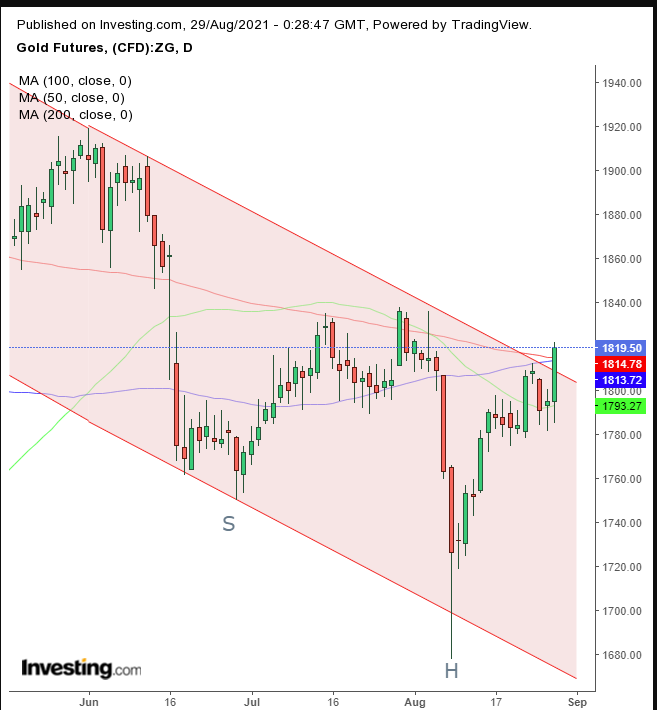
The yellow metal closed above its falling channel, as well as above both the 100 and 200 DMAs. The chart may be developing a H&S bottom, with the 200 DMA as its natural neckline.
Bitcoin traded in a holding pattern on Friday and Saturday. It was as if investors weren’t sure what to make of the Fed's non-announcement from Jackson Hole, about its fiscal policy path going forward.
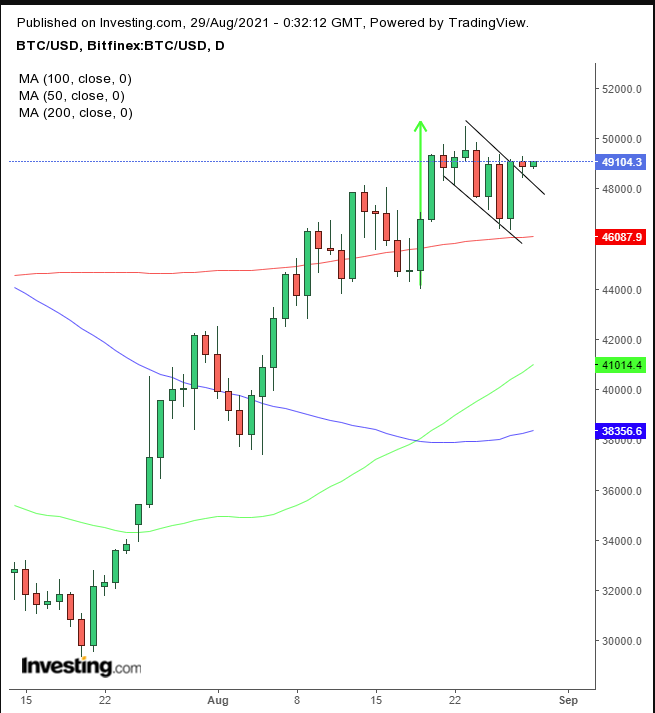
The cryptocurrency may have completed a falling channel, having found support after breaking the resistance of the 200 DMA.
Dollar weakness lifted oil to more than a two-week high, where it closed above the 100 DMA.
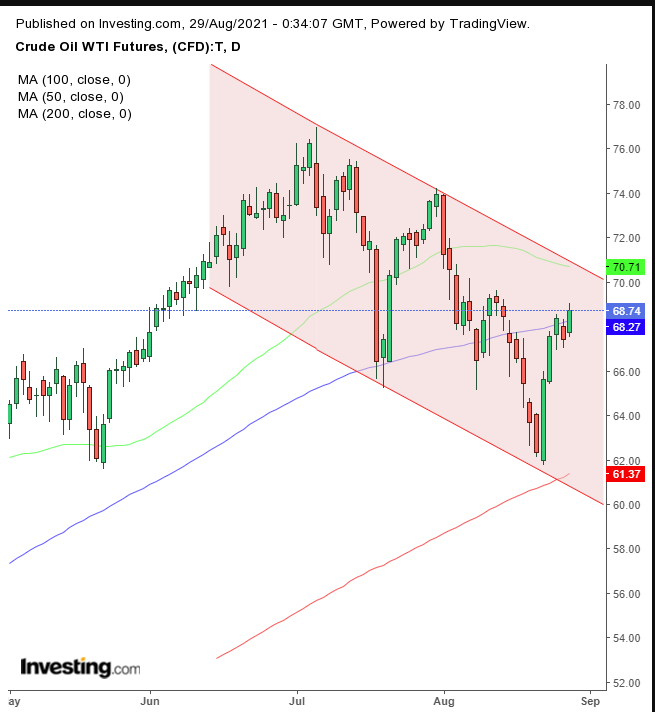
However, the commodity is reaching the top of its falling channel, guarded by the 50 DMA, which raises the odds of a lower turnaround.
Economic Calendar
All times listed are EDT
Monday
10:00: US – Pending Home Sales: expected to rise to 0.4% from -1.9%.
21:00: China – Manufacturing PMI: seen to ease to 50.2 from 50.4.
Tuesday
3:55: Germany – Unemployment Change: forecast to jump to -34K from -91K.
5:00: Eurozone – CPI: probably rose to 2.8% from 2.2%.
8:30: Canada – GDP: predicted to jump to 0.7% from -0.3% MoM.
10:00: US – CB Consumer Confidence: anticipated to edge down to 124.0 from 129.1.
21:30: Australia – GDP: forecast to plunge to 0.5% from 1.8% QoQ.
21:45: China – Caixin Manufacturing PMI: likely to slip lower, to 50.2 rom 50.3.
Wednesday
3:55: Germany – Manufacturing PMI: expected to remain flat at 57.3.
4:30: UK – Manufacturing PMI: due to remain at 60.1.
8:15: US – ADP Nonfarm Employment Change: expected to nearly double to 638K from 330K.
10:00: US – ISM Manufacturing PMI: to drop slightly to 58.5 from 59.5.
10:30: US – Crude Oil Inventories: seen to rise to -2.683M from 2.979M.
Thursday
8:30: US – Initial Jobless Claims: predicted to rise to 345K from 353K.
21:30: Australia – Retail Sales: previous reading was -2.7%.
Friday
4:30: UK – Services PMI: to remain flat at 55.5.
8:30: US – Nonfarm Payrolls: forecast to drop to 728K from 943K.
8:30: US – Unemployment Rate: anticipated to edge down to 5.2% from 5.4%.
10:00: US – ISM Non-Manufacturing PMI: forecast to decline to 61.8 from 64.1.
